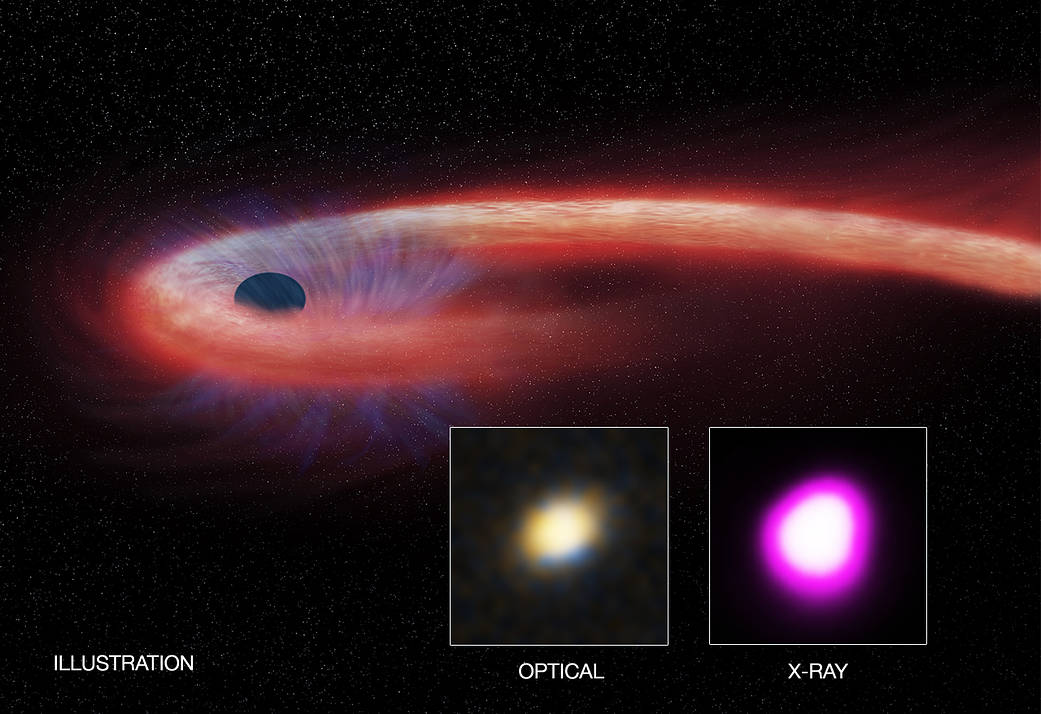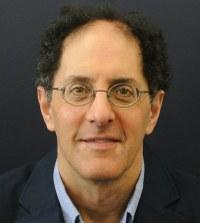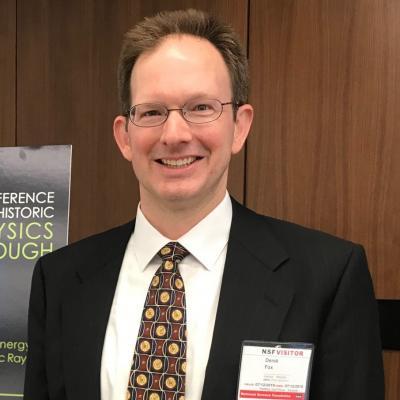
The dynamic universe
Many dynamic phenomena in the universe occur over a period of seconds to years. Events with quickly evolving signals include the explosions of Type 1a supernovae, the destruction of stars passing too close to a black hole, and the merger of neutron stars. Some transient phenomena, like Type Ia supernovae, release light in such a reliable way that they can be used as standard reference events to study the evolution of the universe. Other events provide information about matter in extreme environments and at very high energies. These phenomena may be observed not just through their electromagnetic emission, but also through the generation of particles or gravitational waves. For example, a merger of two neutron stars first detected as a gravitational wave event, GW170817, was subsequently observed across the electromagnetic spectrum. Fluctuations in the energetic matter streaming out from the vicinity of a black hole in the center of a galaxy, the flaring blazar TXS 0506+056, produced both neutrinos detected by IceCube and high-energy gamma rays. Several new instruments promise to bring an explosion of data for the study of transient phenomena in the universe. [Image Credit: Illustration: CXC/M. Weiss; X-ray: NASA/CXC/UNH/D. Lin et al, Optical: CFHT. ]
IGC members who study Dynamic Universe
| Name | Role | Affiliation | Phone | Office Address | Affiliated Center(s) | Research Topics(s) | ||
|---|---|---|---|---|---|---|---|---|
| W. Niel Brandt | Faculty | Astronomy, Physics | wnbrandt@gmail.com | +1 814 865 3509 | 514A Davey Laboratory | CTOC | Quasars, Dynamic Universe, Black Holes, Multimessenger Astrophysics | |
| Tommy Chin | Graduate Student | Physics | wjc5509@psu.edu | 6692331822 | 301D Whitmore Laboratory | CTOC, CFT, IGC | Dynamic Universe, Quantum Universe, Black Holes, Cosmic Surveys | |
 | Douglas Cowen | Faculty | Physics | dfc13@psu.edu | +1 814 863 5943 | 303D Osmond Laboratory | CMA | Dynamic Universe, Neutrinos, Multimessenger Astrophysics |
 | Michael Eracleous | Faculty | Astronomy | mxe17@psu.edu | +1 814 863 6041 | 414 Davey Laboratory | CTOC, CMA | Quasars, Black Holes, Dynamic Universe, Multimessenger Astrophysics |
 | Abe Falcone | Faculty | Astronomy | adf15@psu.edu | +1 814 863 5364 | 516 Davey Laboratory | CMA | Multimessenger Astrophysics, Cosmic Rays, Dynamic Universe, Quasars |
 | Derek Fox | Faculty | Astronomy | dbf11@psu.edu | +1 814 863 4989 | 425 Davey Laboratory | CMA, CTOC | Dynamic Universe, Neutrinos, Multimessenger Astrophysics |
 | Amanpreet Kaur | Faculty | Astronomy | auk971@psu.edu | +1 814 863 9341 | -- NONE | CMA | Dynamic Universe, Astroinformatics |
 | Kyle Neumann | Graduate Student | Astronomy | kdn5172@psu.edu | (814) 865-0418 | 537 Davey Laboratory | IGC | Black Holes, Dynamic Universe, Gravitational Waves, Multimessenger Astrophysics |
 | George Pavlov | Faculty | Astronomy | ggp1@psu.edu | +1 814 865 9482 | 508B Davey Laboratory | CMA | Quasars, Dynamic Universe |
 | Zhibo Yu | Graduate Student | Astronomy | zvy5225@psu.edu | +1 814 2329588 | 440 Davey Laboratory | IGC | Dynamic Universe |
News about Dynamic Universe

NASA’s Chandra identifies a black hole whose bark is worse than its bite
2024-03-21
Astronomers have revealed that a brilliant supermassive black hole is not living up to expectations. Although it is responsible for high levels of radiation and powerful jets, this giant black hole is not as influential on its surroundings as many of its counterparts in other galaxies. A team including IGC faculty W. Niel Brandt, the Eberly Family Chair Professor of Astronomy and Astrophysics and professor of physics at Penn State, recently published this study in the Monthly Notices of the Royal Astronomical Society.
Click here for the full article.
Additional links:

Rare Cosmic Explosion Blasts Hole in Established Science
2022-12-08
On Dec. 11, 2021, the NASA’s Neil Gehrels Swift Observatory, which has its Mission Operations Center at Penn State, detected a blast of high-energy light from a galaxy roughly 1 billion light-years away. The event, which was simultaneously detected by Fermi Gamma-ray Space Telescope, brings into question what was thought to be settled science concerning gamma-ray bursts (GRBs), the most energetic explosions in the universe.
“It was something we had never seen before,” said Simone Dichiara, assistant research professor of astronomy and astrophysics at Penn State and member of the Swift team. “We knew it wasn’t associated with a supernova, the death of a massive star, because it was too close. It was a completely different kind of optical signal, one that we associate with a kilonova, the explosion triggered by colliding neutron stars.”
The Swift team was able to rapidly identify the explosion’s location, in the constellation Boötes, enabling other facilities to quickly respond with follow-up observations. Their observations have provided the earliest look yet at the first stages of a kilonova, according to a NASA release. Their findings were published today (Dec. 7) in the journal Nature.
Gamma-ray bursts come in two varieties: long and short. Scientists previously understood long GRBs, which last a couple of seconds to one minute, as forming when a super massive star explodes as a supernova. Short GRBs, which last less than two seconds, were previously thought to only occur when two compact objects — like two neutron stars or a neutron star and a black hole — collide to form a kilonova.
The revelation that a kilonova could trigger a long gamma-ray burst rewrites the decades-long paradigm of cosmic explosions: that long GRBs are strictly the signature of the death of massive stars, Dichiara explained. The discovery means not all long GRBs are made by supernovae, some are produced by the merger of neutron stars.
“This event was a game-changer that showed to us how our well-established knowledge of the universe was in fact only a partial and incomplete view,” said Eleonora Troja, an astronomer at the University of Rome Tor Vergata and lead author on the paper. “This result was hard to digest at first and we spent months trying to figure out alternative explanations, but in the end this is the only one that works well. Although we have been studying GRBs for decades, it is awesome to see how the universe can surprise us in the most unexpected ways.”
The work was supported by the European Research Council through the Consolidator grant BHianca and by the National Science Foundation.
Click here for the full article.
Additional links:

The Hobby-Eberly Telescope reaches 25th anniversary milestone
2022-11-03
One of the world’s largest optical telescopes, the Hobby-Eberly telescope (HET) at the University of Texas at Austin’s McDonald Observatory, is marking 25 years of investigating the mysteries of the cosmos. The HET’s unique and innovative design was developed by Penn State professors Lawrence W. Ramsey, who has served as the HET’s project scientist and as the chairman of its board of directors, and Daniel W. Weedman in the early 1980s.
The telescope is named for Robert E. Eberly, a Penn State alumnus and benefactor, for whom Penn State’s Eberly College of Science is also named, and former Texas Lieutenant-Governor William P. Hobby.
“This year marks an important milestone for the Hobby-Eberly telescope,” said Taft Armandroff, the Frank and Susan Bash Endowed Chair at UT Austin, Director of McDonald Observatory, and HET board chair. “The HET provides the resources that our faculty and researchers from many different institutions use to do cutting-edge science.”
First dedicated in 1997, the HET is currently a collaboration of four institutions: the University of Texas at Austin, Penn State, the University of Munich, and the University of Goettingen. The telescope, which has an 11-meter (433-inch) primary mirror, received a major upgrade in 2016, expanding its field-of-view to capture a section of the night sky 120-times larger than before. This capability and new instruments were celebrated in a re-dedication event in 2017.
“In addition to its enormous light-gathering power, the HET’s scheduling system allows it to rapidly respond to unusual, transient events in the heavens,” said Ramsey, emeritus professor of astronomy and astrophysics and Eberly College of Science Distinguished Senior Scholar. “This combination allows HET to address a wide range of scientific questions, ranging from exoplanets to the large-scale structure of the universe. In the HET’s first quarter-century, over 450 peer-reviewed papers relied on HET data.”
The Hobby-Eberly Telescope Dark Energy Experiment (HETDEX) is an international collaboration that is probing dark energy, the mysterious force that is accelerating the expansion of the universe, to build an extensive three-dimensional map of the universe when it was but a fraction of its current age. By training the HET on two regions of the sky, one near the Big Dipper and one near Orion, the telescope is capturing the cosmic fingerprint of the light from 2.5 million galaxies. Astronomers are using the Visible Integral-field Replicable Unit Spectrograph, which can simultaneously obtain over 30,000 spectra in a 20-minute exposure, to address a number of fundamental questions, in particular why the expansion of the universe is speeding up over time.
“The HETDEX program involves not only the four university partners but dozens of additional scientists at several institutions from around the world,” said Donald Schneider, distinguished professor in the Department of Astronomy and Astrophysics at Penn State and a HET board member.
HET has played an integral role in finding Earth-sized planets beyond our solar system. The Habitable Zone Planet Finder (HPF), developed by a team of scientists led by Penn State Professor of Astronomy and Astrophysics Suvrath Mahdevan, aims to identify so-called “Goldilocks planets,” exoplanets capable of supporting liquid water on their surfaces. One discovery involved K2-25b, a planet the size of Neptune orbiting a cool star. Using high-time resolution HPF spectroscopy of the system when the planet passed between Earth and the star, astronomers were able to determine the angle between the star’s equator and the orbit of the planet, which offers insights into the formation and evolution of planetary systems.
“A lot of the public thinks science has these eureka moments, but most major scientific discoveries are met with ‘hmm, that’s funny,’” said Bill Cochran, research professor at UT Austin and chair of the HET Users Committee. “Whether or not a planet is habitable is not the right question. I am interested in how the planet evolved, and I want to use the findings with the HPF to pursue these questions with my colleagues in different disciplines.”
Click here for the full article.
Additional links:

NASA selects STAR-X for $3M mission concept study
2022-08-30
STAR-X, the Survey and Time-domain Astrophysical Research Explorer, a proposed NASA Medium-Class Explorer (MIDEX) mission that includes Penn State astronomer Niel Brandt, has been selected by the NASA Explorers Program for further study. STAR-X is one of two proposed MIDEX missions that will receive $3 million for a nine-month detailed study of mission requirements. At the end of this period, one of the proposed missions will be selected for a target launch date in 2027-2028 and be eligible for up to $300 million in additional funding.
Comprised of an X-ray telescope, an ultraviolet (UV) telescope, and a responsive spacecraft, STAR-X is designed to conduct time-domain surveys, which study how astronomical objects change with time, and to respond rapidly to transient cosmic events discovered by other observatories such as LIGO, Rubin LSST, the Roman Space Telescope, and the Square Kilometer Array. The mission is led by Principal Investigator William Zhang at NASA’s Goddard Space Flight Center (GSFC) in Greenbelt, Maryland. Penn State’s Brandt, who is the Verne M. Willaman Professor of Astronomy and Astrophysics and Professor of Physics, is involved in planning the STAR-X cosmic X-ray surveys, active galaxy studies, and fast X-ray transient studies.
“I can’t wait to use STAR-X to investigate the first supermassive black holes and understand mysterious, explosive X-ray transient sources,” said Brandt. “STAR-X will also provide the essential X-ray and UV follow-up capabilities for remarkable cosmic objects discovered by the Rubin LSST in optical light.”
The STAR-X spacecraft would be able to turn rapidly to point a sensitive wide-field X-ray telescope and a UV telescope at transient cosmic sources, such as supernova explosions and feeding supermassive black holes. Deep X-ray surveys would map black holes and hot gas trapped in distant clusters of galaxies; combined with infrared observations from NASA’s upcoming Roman Space Telescope, these observations would trace how massive clusters of galaxies built up over cosmic history.
STAR-X would provide revolutionary capabilities including unprecedented X-ray and UV volumetric survey speed; a unique combination of large field-of-view, large X-ray collecting area, low background, and excellent imaging; increased sensitivity for characterizing diffuse emissions, and increased speed and sensitivity for the discovery of faint X-ray point sources. It fills the gap in X-ray and UV survey coverage, providing simultaneous X-ray and UV observations, which are among the earliest and most uniquely informative astrophysical signals that probe the inner regions around compact objects like black holes and neutron stars, and it complements optical, infrared, and gravitational wave facilities.
The mission’s Deputy Principal Investigator, Ann Hornschemeier, who is also Lab Chief for X-ray Astrophysics at GSFC, earned a Ph.D. in Astronomy and Astrophysics at Penn State, mentored by Brandt, in 2002.
“Ann is superb - a bundle of energy, and the right person to push STAR-X to succeed,” said Brandt.
NASA Explorer missions conduct focused scientific investigations and develop instruments that fill scientific gaps between the agency’s larger space science missions. The proposals were competitively selected based on potential science value and feasibility of development plans. The Explorers Program is the oldest continuous NASA program and is designed to provide frequent, low-cost access to space using principal investigator-led space science investigations relevant to the Science Mission Directorate’s astrophysics and heliophysics programs.
“NASA’s Explorers Program has a proud tradition of supporting innovative approaches to exceptional science, and these selections hold that same promise,” said Thomas Zurbuchen, associate administrator for NASA’s Science Mission Directorate at NASA Headquarters in Washington. “From studying the evolution of galaxies to explosive, high-energy events, these proposals are inspiring in their scope and creativity to explore the unknown in our universe.”
Since the launch of Explorer 1 in 1958, which discovered the Earth’s radiation belts, the Explorers Program has launched more than 90 missions, including the Uhuru and Cosmic Background Explorer (COBE) missions that led to Nobel prizes for their investigators.
The program is managed by NASA Goddard for NASA’s Science Mission Directorate in Washington, which conducts a wide variety of research and scientific exploration programs for Earth studies, space weather, the solar system, and the universe. More information can be found at the Explorers Program website (https://explorers.gsfc.nasa.gov/).
Further technical details about the observatory are available at (http://star-x.xraydeep.org/observatory/).
Click here for the full article.
Additional links:
